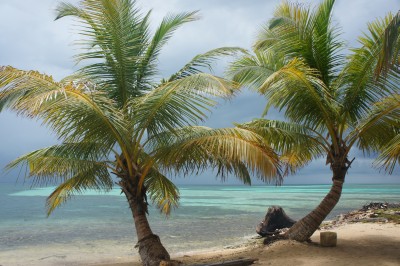
Belize: Small Country, Big Attractions
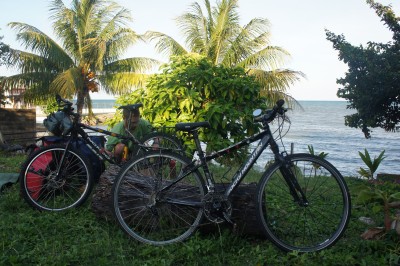
Bang! The boat jumped into the air and crashed hard again. The ocean was rough, the waves were huge and we were going at full speed. We had arrived to Puerto Barrios, Guatemala that afternoon after a pleasant ride from Honduras and were surprised to discover that we could still catch a boat to Belize that day. We left late and the captain was in a hurry. As we were leaving it started raining hard and we were given black plastic bags to cover ourselves. When the rain stopped I peeked out and saw the most beautiful double rainbow, and I thought that maybe I died and arrived to heaven, but for some reason it still felt like hell. The whole time I was just hoping that we would make it out OK. That was the only thing that mattered.
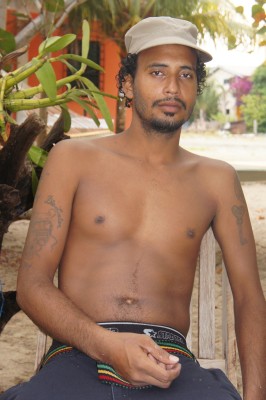
We arrived to Punta Gorda, Belize, shaken, disoriented and in pain, and had to take the next day to recuperate. After almost five months of riding we were never in so much pain as after that boat ride. I actually had bruises on my back and Gili’s legs were so stiff we could both hardly move.
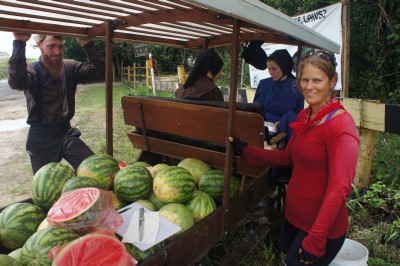
Things picked up quickly after that, and how could they not? We were in Belize, where “every little thing was gonna be all right”. The first thing I found fascinating about Belize is how multicultural it was. There are the Maya people, who still live in their traditional thatched roof houses and speak their own languages. Then there are the Mennonites, originally from Germany but arrived to Belize via Canada and Mexico. Most of them do not use electricity and they get around with horse carriages. Agriculture is their main business, and they produce most of the fruit and vegetables in Belize. There are also East Indians with small businesses, and Guatemalan immigrants who speak Spanish and are the only reminder that this country is in Central America, otherwise the majority speak English. Then there are the Chinese, who just like in Panama, have cornered the supermarket industry, and of course, there are the Afro-Caribbeans, with their wide smiles and neat fuzzy hair styles.
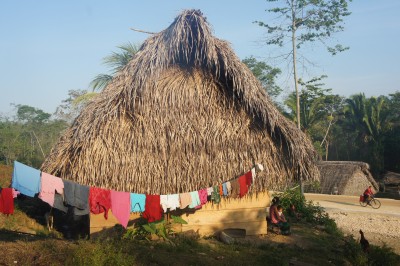
At first we explored the Maya villages in the south and were amazed by the warm welcome and hospitality we encountered. In the village of San Antonio a family invited us over for a bowl of boiling “caldo de pollo” (chicken soup), and a mildly hot cacao drink that we later discovered was being mixed by inserting a dirty looking hand and swishing around.
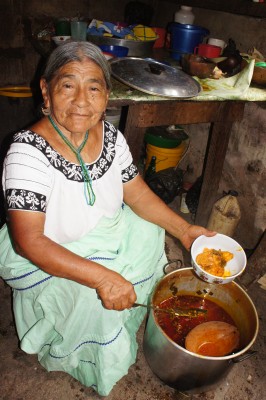
We spent the night in the yard of one extended family in the village of Santa Cruz, right by their thatched house. We loved the cultural experience, but the people who hosted us found us fascinating too. They had never seen a tent and everyone, including the grandma, came to take a look. The kids passed the evening by playing inside the tent, having the time of their lives.
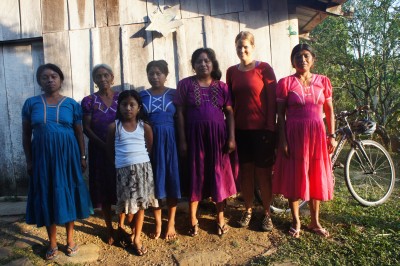
The village was not connected to electricity and most people got their water by walking down to the main village well. We were interested in their house and structure, and in return they asked us about our living arrangements. We told them that we used to live in a high building with an elevator, but had to explain what an elevator was, because they had never seen or heard of elevators. Of course my name was a real hit and they couldn’t get over the fact that my name was really Maya.
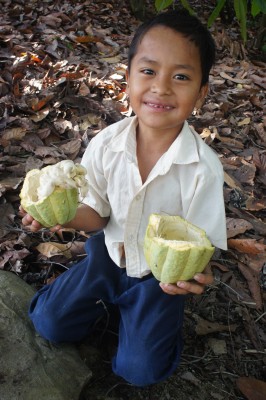
The area of southern Belize is famous for its cacao. When we stopped by a cacao orchard, eight year old Nehimiah appeared and volunteered to climb a tree to pick a few cacao fruit for us. Like a monkey he climbed with ease and picked the ripe fruit, and then broke the cacao open for us by knocking it on a rock. The white gooey stuff that covers the beans is really tasty, and we enjoyed it while conversing with Nehimiah about our trip and his life in Belize.
We also visited four different small factories where they make chocolate. After tasting them all we concluded that they were all excellent, smooth, fruity, and very fresh, although we appreciated more the chocolate made by local Maya families than those who are manufactured by foreigners. Every time we bought chocolate and tried to keep it for later, it completely melted but the end result was still good, especially eating it with a banana.
Belize is sparsely populated with only 300,000 people, so most of the villages and towns we passed through were very small. One evening when we were looking for a place to camp for the night we found Dennis and his family, just a single farm exactly where we needed it. Dennis and his wife America raise their five children there, and grow most of their food on their farm.
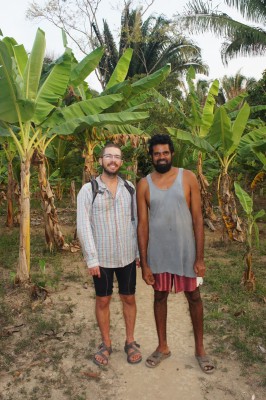
He kindly invited us over and offered us many delicious treats during our short stay. First, sweet elongated coconuts, then the best fish soup we have had, made from fish he had caught in the river, and for a late night treat fried plantains from his farm. He also took us on a short tour showing us around his farm, the different trees they grow and the animals. In the morning we were invited for eggs and fresh flour tortillas, and were even given two souvenirs, a pot holder he knitted and a key chain of Belize.
We then spent a few days in the more touristy town of Placencia. We camped in Calvin’s back yard, which was basically a private beach. We went with Shane on a snorkeling trip and while we snorkeled he was busy spear fishing and later took us to his uncle’s private island where he cooked those fish and conch with potatoes, on a smoking hot wood fire, a real feast.
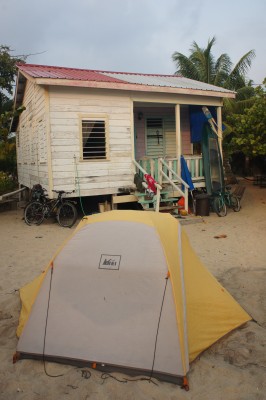
The ride along the Sittee River was peaceful and full of bread fruit trees, but unfortunately the fruit is not so good for eating. However, the jack fruit we were offered by Wendell McDougal was a delight. The fruit weighs up to 20lbs, and the yellow flesh is eaten by hand, and very sweet and sticky. We stayed in a wooden cabin just above the river, enjoying the nature and wild life. In the nearby Garifuna village of Hopkins we enjoyed excellent local food such as Bundiga, grated green bananas cooked in a creamy coconut sauce served with fish, and Hudut, a rich fish coconut soup with mashed plantains.

Then came a few relaxing days on Tobacco Caye. It’s a tiny island, and if you walk really slowly you can circle it in five minutes. Our main concern during those four days was where to find the best snorkeling spot, which we easily discovered. The water was so clear that we spotted many sting rays even while standing on the dock. We were definitely getting into the rainy season, but luckily most of the time it rained during the night, with dramatic storms, heavy rain, and strong winds that made our tent shake.
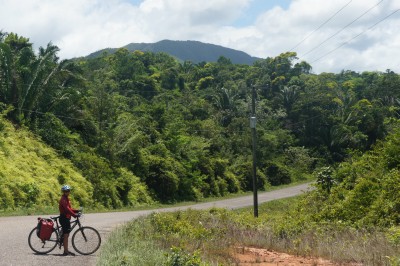
The Hummingbird Highway offered a blessed change of scenery, with rolling hills, the forested (and well named) Maya mountains and a few rivers to swim in. Otherwise the roads in Belize were boring, with pine tree farms on both sides of the road making the ride very monotonous and mentally challenging. What was nice though was the little traffic on the roads with barely any cars even on the main highway. Belize was also the flattest country we’ve ridden in, so at least it wasn’t physically difficult and our progress was decent.
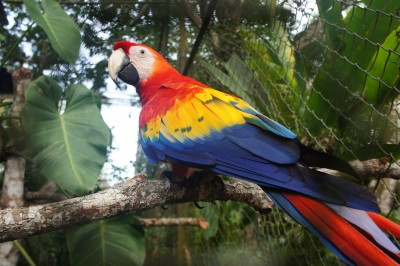
On the way to Belize city we explored the zoo, where most of the animals were rescued or are being protected from hunters. The highlights were jaguars, Belize’s official animal – the Tapir, and the ever colourful toucans and scarlet macaws.
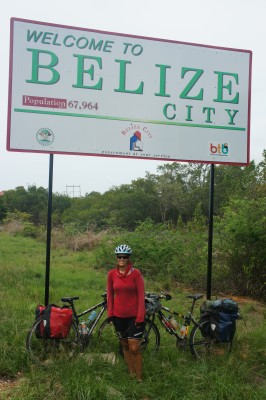
Belize city is the largest city in Belize with only 70,000 people, however it did not feel like cycling into a big city. Without much of the hassle that sometimes happens while cycling into a metropolitan, we suddenly found ourselves in downtown Belize City, the last destination of this trip, or at least the last destination reached by bicycle. After five months and over 4,300km it felt good to put down the bike with a great feeling of accomplishment of completing an incredible journey.
With a couple of days to spare till our flight and seeing that Belize City was not the most interesting or the nicest place, we decided to head to the island of Caye Caulker, a popular backpacker hangout. There we hopped on a snorkeling tour and finished our trip by swimming with huge manatees, numerous nurse sharks, sea turtles, sting rays and other big and colourful fish.
After five months, it was time to box the bikes again, and we felt more than ready to return to beautiful Vancouver. Fourteen hours after we left Belize City we were home again. The journey was now complete.

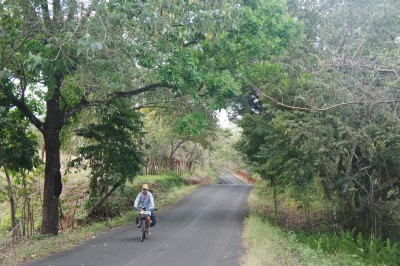
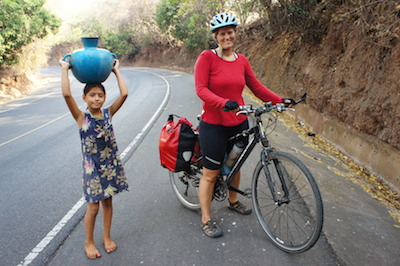
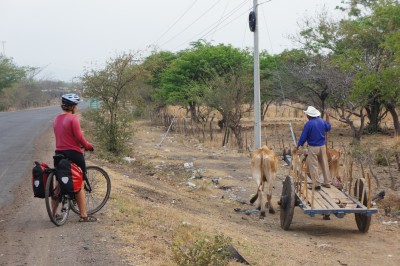
7 Comments
Nicole
Wow!! Congratulations on completing a mammoth achievement … 5 months and 4300 km by bicycle!!
Wonderful unique photos- each one tells a story….
Put the giant leap picture in the blog!!!
Thinking of you….
Philippe
Dear Maya and Gili,
Congratulations to both of your for undertaking such a neat and demanding journey. Your reports were a real treat, with so people met, stories told and great pictures to show. We very much look forward to seeing both of you!
Jan & Warrick
What a terrific journey, all that food, fruit, beaches, experiences, people and more, you will be sooo fit. Welcome back and see you when you are settled.
Gili
Thanks everyone! It was an incredible journey, and of course it’s great to be back in Vancouver, but I can’t help but think about the next trip… 🙂
Pingback:
Pingback:
Pingback: